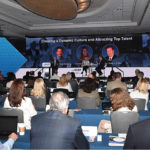
Did I know, the cab driver asked as we traveled along leafy streets between Tegel Airport and East Berlin, that the airport was built for the 1948 Berlin Airlift, when the West flew in food and supplies after the Soviet Union blockaded land routes into the city?
The past, I would find, is never far away in Berlin, and – as I also learned —there’s never been a better time to meet there. The city ranks first for meetings in Europe and is the fourth most-popular city globally for association meetings, according to the International Congress and Convention Association. New hotels and restaurants, commercial and civic developments, and cultural institutions have remade Berlin’s skyline over the last decade, and reconfigured the size and scope of the meetings and events industry, whose revenue has doubled, while the number of hotel room nights generated by meetings has tripled.
I stayed with a group of North American and Brazilian planners – all of us headed to IMEX in Frankfurt the following week – at the sleek and stylish, 557-room andel’s Hotel Berlin, whose 14-story-high Sky Bar features prime views of the Soviet-built Television Tower on Alexanderplatz, an East Berlin landmark. The spacious property offers 40,000 square feet of meeting space, four restaurants, and an in-house events team.
After cocktails, dinner our first night was at the classically elegant, 278-room Hotel Palace Berlin, near the Berlin Zoo and Tiergarten Park in West Berlin. The hotel’s second-floor conference level provides 26,000 square feet of meeting space in 17 rooms and can accommodate groups of up to 900 people.
The next morning, we toured the city’s landmarks, including such icons as The Reichstag, graffiti-covered remnants of the Berlin Wall, and Museum Island, along with relative newcomers like the modernist 2001 Jewish Museum. Then we walked through the front door of an unassumingly boxy building, just steps away from the Brandenburg Gate, to find stunning organic forms created in wood, glass, and steel. The building, housing offices and the Axica meeting venue, was designed by Frank Gehry, who has called it his best work. The venue’s spaces can accommodate a variety of meeting and events, including a reception for 600.
Germany leads the world in environmental technology, and green meetings are a way of life in Berlin, said Laura d’Elsa, GCB’s regional director for the United States and Canada. (There are so many solar arrays on the city’s rooftops that, as my plane landed, the sun glancing off them made me think of flashbulbs at a red-carpet event.) Our group visited the city’s first carbon-neutral venue, the tent-shaped Tempodrom Berlin, which originated as an actual canvas tent where punk concerts were staged. The venue’s arena can seat 3,500 attendees.
We took another turn around the historic city center on Sunday morning, but this time in a caravan of noisy, East German–made Trabants, which feature a two-stroke, 40-horsepower engine. The car has become a collector’s item, and as we rumbled around Berlin in an excursion organized by TrabiSafari, we were as much tourist attraction as tourists.
That afternoon, we traveled by bus to Potsdam, whose palaces and gardens – including Sanssouci, Frederick the Great’s summer palace – are on UNESCO’s World Cultural Heritage list. In the summer of 1945, the Cecilienhof Palace hosted the Potsdam Conference, where the Allied Powers divided Germany and the city of Berlin into four zones. The city’s charm and natural beauty – it sits on the River Havel, 15 miles from Berlin – make it a popular meeting place today.
We stopped for lunch and a tour at Kongresshotel Potsdam, which sits on the shores of Lake Templiner, on the forested grounds where Count Zeppelin built his namesake airship. The architecture of the airy, 485-room hotel pays homage to the Zeppelin, seeming to sail toward the lake. A conference hall and 45 meeting rooms are built on what formerly were production and maintenance plant areas for the airships.
We spent our last evening at Estrel Berlin, Germany’s largest hotel and conference center, with 1,125 rooms, more than 161,000 square feet of meeting space, a waterfront beer garden, and its own Las Vegas–style “Stars in Concert” dinner and show. A large scientific conference was getting under way as we arrived, yet the venue still felt roomy. Candlelight – and some of the warmest hospitality of our trip – made our farewell dinner inside a soaring glass atrium with five restaurants and bars feel cozy.
For more information: gcb.de.



